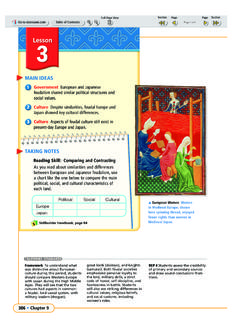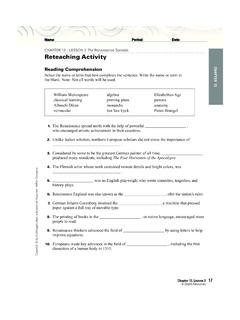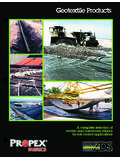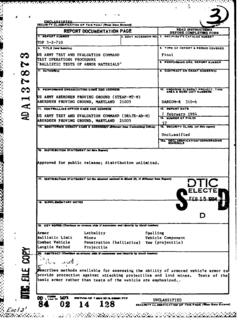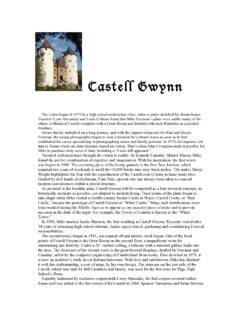Transcription of i - CA
1 Page 1 of 6. Lesson 1. MAIN IDEAS. Culture Key events brought an end to the Middle Ages and feudal life. Economics Toward the end of the Middle Ages, trade flourished. This brought new goods and ideas to an increasing number of people. Belief Systems The movement known as humanism stressed the importance of individuals and encouraged human achievement. TAKING NOTES. Reading Skill: Categorizing When you categorize, you sort things into groups with similar characteristics. Use a chart like the one shown below to describe the new ways of thinking brought on by humanism. Impact of Humanism Old Thinking New Thinking Marco Polo The Italian king and Church trader Marco Polo helped to most important build trade between Europe and Asia with his journeys across the Silk Roads. Skillbuilder Handbook, page R6. Describe the way in which Understand the effects of CST 3 Students use a variety of the revival of classical learning and the reopening of the ancient Silk maps and documents to identify the arts fostered a new interest in Road between Europe and China, physical and cultural features humanism ( , a balance between including Marco Polo's travels and of neighborhoods, cities, states, intellect and religious faith).
2 The location of his routes. and countries and to explain the historical migration of people, expansion and disintegration of empires, and the growth of economic systems. 428 Chapter 13. Page 2 of 6. TERMS & NAMES. Silk Roads Origins of the humanism Renaissance Build on What You Know The arts refers to a broad range of cultural activities and creations. Consider your favorite movies or music. They are all part of the arts. So too are painting, sculpture, literature, and architecture. In this chapter, you will learn about one of the most significant periods of artistic advancement in Western history. European Society Changes ESSENTIAL QUESTION What events helped bring an end to feudalism and the Middle Ages? As you read in Chapter 10, a number of key events took place in Europe during the late Middle Ages. They included the growth of nations, the onset of a deadly plague, and the Hundred Years' War. All of these events combined to bring an end to feudal society.
3 The Rise of Nations Under feudalism, numerous small kingdoms ruled Europe. This began to change with the development of England and France as nations during the 1100s and 1200s. Monastery Ruins As you recall, William the Conqueror led a group known as the As the Middle Ages Normans in conquering all of England. In France, the nobles who ended, so did the use ruled Paris gradually increased their power and territory until they of many monasteries ruled much of the land. Eventually, England and France became across Europe . unified countries under a single government or ruler. As a result, including this one in Yorkshire, England.. individual lords and landowners lost much of their power. 429. Page 3 of 6. End of Medieval Institutions The feudal way of life also suffered a setback with the onset of a widespread plague and the Hundred Years'. War during the 1300s. The deadly plague led to a large population decline throughout Europe.
4 This meant that there were fewer serfs to work the land. As a result, the feudal system weakened. Meanwhile, the Hundred Years' War between England and France spelled an end to the age of chivalry. The war featured the use of the longbow, which could penetrate armor from a long distance. This new weapon quickly made knights and their hand-to-hand style of fighting all but useless. What role did the plague and the Hundred Years' War play in the decline of feudalism? The Expansion of Trade ESSENTIAL QUESTION What effect did the reopening of the Silk Roads have on Europe? Mongol Tile This star-shaped tile As the feudal system faded, cities throughout Europe continued came from the to grow. This was due in large part to the expansion of trade and Mongol Empire the development of a strong merchant class. As you recall from that Marco Polo Chapters 9 and 10, Europe experienced a revival of trade during visited.
5 The late Middle Ages. The main reason for the growth of trade was a gradual decline in warfare and invasion. As a result, traders once again felt safe to travel long distances. The Silk Roads Reopen Perhaps the most notable example of the return of long-distance trade was the reopening of the Silk Roads. The Silk Roads were an ancient trade route that connected Europe with China. After the fall of Rome, many viewed the roads as too dangerous. As a result, the nearly 5,000-mile route saw little use. The rise of the Mongol Empire brought security to the region, which led to an increase in trade along the Silk Roads during the early 1200s. Then, in 1271, an Italian trader named Marco Polo started a journey along the route. Eventually, he reached China. 430 Chapter 13. Page 4 of 6. Marco Polo's Travels, N. 1271 1295. 60 N. 80. 0 500 1,000 miles 0 500 1,000 kilometers 160. E. Silk Roads Venice N Marco Polo's routes (1271 95).
6 W E Mongol Empire BYZANTINE. EMPIRE S. ConstantinopleB. lac k N. M. ed Se 40. Se ite a a rr a Lake Aral ne Baikal ian Sea A S I A. an Sea Sea Karakorum of Lake Japan C a sp Acre Balkhash Khanbalik Baghdad Kashgar (Beijing). Yellow Red Sea Sea Balkh TIBET East CHINA China ARABIA Sea Arabian Topic of C a n c er Sea South China Sea Bay GEOGRAPHY SKILLBUILDER of INTERPRETING MAPS Bengal Location How did Marco Polo's route to and from China differ? 0 . r 80 E Eq u a to 120 E. After 24 years, Polo returned to Italy with tales of great riches from Asia. He wrote about the many places he visited in China, .. no , Inc. fewer than a thousand carriages and packhorses loaded with raw silk, McDougal-Littell, make their daily entry; and gold tissues and silks of 7thvarious grade World kinds History are Program wh07pe-071301-003. manufactured to an immense extent. Marco Polo's Travels The success of Polo's journey encouraged European merchants todate: 7/30/04.
7 Final proof increase their trade with Asia. This growth of trade with Asia opened Europeans up to a host of new goods and ideas. How did Marco Polo contribute to the growth of European trade? New Ways of Thinking ESSENTIAL QUESTION What is humanism? The events of the late Middle Ages had a great effect on many Europeans. Those who survived the years of plague and war wanted to celebrate and enjoy life. Meanwhile, the growth of trade introduced more people to new goods and ideas. As a result, new attitudes spread across Europe and helped to create new ways of thinking. The Renaissance 431. Page 5 of 6. Revival of Classical Learning The end of the Middle Ages brought the return of learning to Europe. As you recall, education had declined during the Middle Ages. This was due largely to the fact that war and political instability had disrupted society. By the 1200s, however, people had grown eager once again to gain knowledge and understanding.
8 To achieve greater knowledge, many people turned to the past. They revived the classical ideas of Greece and Rome. They studied a variety of texts from these earlier civilizations in the hopes of gaining greater knowledge and fulfillment. The Growth of Humanism The study of classical texts and ideas led to a movement known as humanism. Humanism is a way of thought that focuses on human beings and their potential for achievement. It stresses the study of such classical subjects as history, grammar, literature, and philosophy. The goal of humanism is to create well-rounded individuals and encourage people to achieve all they could in life. The early leader of the humanist movement was an Italian poet and scholar named Petrarch. He was one of the first thinkers to stress the value of classical learning, or the teachings of Greece and Rome. He worked to find and restore the works of many important Greek and Roman writers.
9 In fact, scholars believe that such significant Latin writers as Cicero Humanist Leader and Livy might be unknown today if Petrarch had not dug up The early humanist their lost works buried in monastery libraries. leader Petrarch helped to preserve Humanist Thought Humanism stressed the importance of the work of classical the individual. This way of thinking differed greatly from that of writers such as Livy, medieval times which placed kings and institutions such as the an example of whose Church above everything else. Humanism also promoted a greater writing is shown here. balance between intellect and religious faith. Humanist thinkers stressed the importance of leading a Christian life. However, they challenged people to think for themselves and not blindly accept church orders. They also taught that people could enjoy life and still be good Christians. This teaching differed from earlier beliefs that one had to avoid life's pleasures in order to please God.
10 432 Chapter 13. Page 6 of 6. A New Age of Creativity Humanism helped to strengthen the growing desire among people to experiment, explore, and create. Indeed, in the wealthy cities of Italy such activities had already begun. In the next lesson, you will read about an explosion of creativity, learning, and discovery that began on the Italian peninsula and gradually spread throughout Europe. This movement is known as the Renaissance, and it touched nearly every aspect of life. It signaled the end of the Middle Ages and the beginning of a new era. How did the ideas of humanism differ from the beliefs of the Middle Ages? Lesson Summary A number of factors combined to bring about an end to the Middle Ages and the feudal way of life. An increase in trade and the reopening of the Silk Roads brought new goods and ideas to more people. Humanism stressed the importance of individuals and encouraged human achievement.
